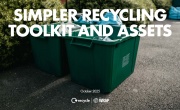75 per cent of Welsh residual business waste is recyclable, says WRAP
A new report from the Waste and Resources Action Programme (WRAP) Cymru has found that 75 per cent of commercial and industrial (C&I) waste sent to incineration or landfill in Wales is recyclable.

Assessing the composition of mixed residual C&I waste, the survey analysed 108 samples of waste from four main sites – Pwllfawatkin landfill, Swansea Baling Plant, Cardiff Energy Recovery Facility and Bessemer Close waste transfer station – in order to provide the Welsh Government with up-to-date data, with the most recent study of this type published in 2007.
Overall, the report estimated that 604,623 tonnes of C&I waste is currently generated in Wales per annum – down by more than 80,000 tonnes from the 686,000 tonnes generated in 2007.
The report found that paper and board was the most common material in the C&I waste analysed, accounting for 25.7 per cent, whilst a further 22.7 per cent of the waste was plastics and 17.9 per cent organic material.
Compared to 2007, the proportion of plastics and organic matter has increased by 7.9 per cent and 2.9 per cent respectively, whilst the amount of paper and board in the C&I waste had decreased by 6.6 per cent.
The proportion of material that could have been recycled or composted has decreased by only two per cent in 12 years, falling from 77 per cent in 2007 to 75 per cent in 2019.
Out of the 452,258 tonnes of materials that could be diverted from the residual waste stream, edible food waste was the most prevalent, with an estimated 68,679 tonnes arising per annum. The report does acknowledge, however, that this data should be treated with caution, as half of the industrial waste sample originated from food production facilities, which could have overestimated the proportion of food waste.
Meeting Wales’ recycling targets
With such a high proportion of recyclable material being sent to landfill or incineration, Wales’ C&I waste could stand in the way of the nation achieving its ambitious recycling targets – the Welsh Government’s ‘Beyond Recycling’ strategy outlines plans to achieve a recycling rate of 100 per cent across all sectors by 2050, with an interim target of a 70 per cent household, municipal and industrial recycling rate by 2025.
Calling for recyclable material to be removed from incinerator feedstock, Shlomo Dowen, National Coordinator of the UK Without Incineration Network (UKWIN), which runs the anti-incineration ‘Bin the Burners’ campaign seeking to end the construction of new incinerators in the UK, said: “UKWIN welcomes this WRAP report, which helps us better understand how most of what is described as ‘residual waste’ is actually a resource that should be utilised and not incinerated.
“If incinerator feedstock were strictly limited to only genuinely residual material then this would free up capacity at existing incinerators, thereby removing any justification for building any new incineration capacity in Wales and indeed anywhere in the UK.”
Eleonore Soubeyran, Policy and Parliamentary Affairs Officer at the Environmental Services Association (ESA), highlights the need for investment in recycling infrastructure: “Whilst the study shows that commercial and industrial waste that could have potentially been diverted from landfill and incineration in Wales has decreased, still 75 per cent of this waste was potentially recyclable with the largest part being edible food waste.
“This study reinforces ESA’s position that strong policies are needed to stimulate recycling. For too long, recycling has been impeded by a lack of recycling infrastructures, a lack of sustainable end-markets and poor quality recycled materials. Recycling is inhibited by competition with virgin material, not enough energy from waste or landfill. The sector needs long-term policy and regulatory clarity to unlock investment in new recycling infrastructures, and policy should tackle quality and demand rather than evermore ‘push’ measures that encourage collection of low-value material with no viable recycling outlet.”
You can read the report, ‘Composition analysis of commercial and industrial waste in Wales’, on the WRAP Cymru website.








